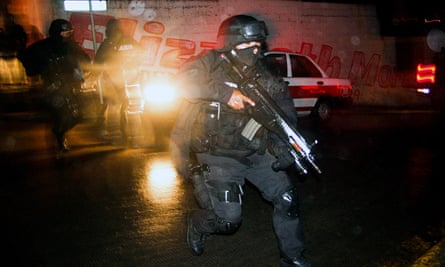Lizbeth Amores dropped off her son at her mother’s house before heading to a house party with her friend Verenice Guevara. They were last seen at a bar popular with local gangsters.
The following night, María de Jesús Marthen was among a dozen or so young women invited to a private party at a ranch about an hour east of the city centre. On her way to the event, Marthen messaged her boyfriend, pleading for help.
The next night, Karla Saldaña and her friend Luisa Quintana went out for tacos. They were spotted leaving a bar in an unknown vehicle.
None of them were ever seen again, but they were not the only women to vanish: over the space of three nights in November 2011, at least 50 women disappeared in similar circumstances from Xalapa, the capital of Veracruz state, which had been convulsed by cartel violence and political volatility.
Most of the missing women were in their 20s and came from modest families. Some were single mothers, some full-time sex workers, others were students and wannabe beauty queens.
According to documents from the official investigation seen by the Guardian, many of them worked as high-class escorts or hostesses contracted for political events – as well as more exclusive parties attended by government officials and leaders of the feared Zetas drug cartel.
Their fate remains unknown, but they are believed to have been forcibly “disappeared” because they knew too much about corrupt relationships between Mexican politicians and cartel bosses.
Ten years ago this week, Mexico’s then-president Felipe Calderón deployed thousands of troops to fight against organized crime, at the start of what became an all-out war on drug trafficking which has raged ever since.
Since then, more than 100 of the country’s most wanted drug traffickers have been captured or killed. Billions of dollars have been spent, but the campaign has not ended the narcotics trade, or enforced the rule of law.
On the contrary, the decade-long war has had a devastating impact on the country’s social fabric: violent crimes perpetrated organised crime factions – and the security forces themselves – have spread amid almost total impunity.
The human cost has been catastrophic: about 200,000 people have been murdered and at least 28,000 “disappeared” since 2007. Abuses by security forces are widespread.
Most of the victims have been men, but women also have been tortured, trafficked and targeted for particular brutality, with almost total impunity.
Official records indicate almost 7,000 women and girls have disappeared since 2007. But activists say the reality is much worse. The government register of the missing includes 164 women from Veracruz, yet a local monitoring group has documented almost 500 cases of girls and women who have vanished in the past three years alone.
Rupert Knox, Amnesty International’s lead investigator in Mexico until 2015, said: “In this climate of corruption and impunity – where security policies are determined by links between criminal networks, party politics and business interests – opportunities for targeting women and girls are closely connected with the knowledge that no one will do anything serious to protect them.”
Between 2007 and 2015, almost 20,000 women were murdered – a 49% increase on the previous decade, according to the National Statistics Institute (INEGI).
In Veracruz, an oil-rich state on the Gulf coast with a population of eight million, 168 women have been killed this year.
The region’s strategic location and the vast port in its largest city has made it a historically important route for drugs and contraband; political power has long depended on deals with big landowners and crime bosses.
The previously unreported disappearance – and probable murder – of the 50 or so young women happened at a time when the Zetas were losing their grip on the state, which they had previously controlled for several years. The cartel, which was founded by defectors from army special forces, had established itself during the 2004-10 governorship of Fidel Herrera, when military operations appeared to focus on the historically powerful Gulf cartel.
But in 2011 Herrera’s successor, Javier Duarte, opted to carve his own path rather than honour existing political pacts. Violence rose across the state; gun battles became commonplace, and dismembered bodies were dumped on the streets of Xalapa.

At the time Karla Saldaña, 20, was studying education at university. She drove an expensive car and had undergone cosmetic surgery paid for by a local business owner, which earned her the nickname Barbie. Her parents now know that she worked as an escort at events frequented by politicians and Zeta leaders. She and her friend Luisa Quintana were last seen on 29 November 2011.
“I’ve been investigating my daughter’s case since the day she never came home, and while at first I wanted to believe they’d been trafficked, I now know they must be dead. The girls knew too much, they saw and heard things at these parties, who was mixing with who,” said her father, Carlos.
The final location of Saldaña’s cellphone was traced to an isolated mountainside near the border with Puebla, where one of the Zeta strongmen had ties. But the area has never been searched, and the investigation into her disappearance has gone nowhere.
Mexico’s security forces are routinely accused of committing the very crimes they were supposed to prevent. Scores of innocent women have been illegally arrested and tortured in order to elicit confessions and boost prosecution rates.
Troops were deployed in the streets without proper training in non-combat situations, and according to the United Nations, state, local and federal forces have all committed torture and abuse.

In Veracruz, Duarte requested federal forces soon after taking power.
“The navy were told to clean up the state, to arrest or kill everyone who they suspected of working with the Zetas, quickly, before the media, human rights and international organisations interfered,” said a former prosecutor, who asked to remain anonymous for fear of repercussions.
One such unit was posted to Poza Rica, a small city near the border with Tamaulipas, which had once been a centre of the state’s oil boom, but became a focus for organized crime.
In August 2011, Carolina Rosales, 24, a nursery assistant, was detained in an operation targeting a man – a suspected Zeta kidnapper – who’d been her boyfriend for a few weeks. For four days she was kept blindfolded at secret military bases, beaten and sexually tortured.
“A man in normal clothes came saying he was from the human rights department, and was going to photograph my injuries in the bathroom. He raped me,” said Rosales, in a prison interview in Mexico City.
During the attack a uniformed marine entered the room. “He offered to help; he raped me too.”
Rosales was held for several weeks without access to a lawyer before she was charged as an accomplice. She told doctors about the rapes; they prescribed a powerful cocktail of psychotropic medication, which she has only recently managed to wean herself off.
In 2013, prison doctors diagnosed her with HIV, contracted during the rape. The following year Rosales was sentenced to 39 years in prison despite an expert report confirming she had been tortured and left with chronic physical and mental illnesses. When she appealed, the sentence was increased to 51 years.
Rosales has seen her son, aged eight, only five times in the past five years.
After her arrest, Rosales said that one marine told her that he worked for the Gulf cartel. “I couldn’t believe it then, but I do now,” she said. “The armed forces are just criminals in uniforms.”
In Veracruz, violence gradually dropped as Zeta leaders were killed or captured, but those who survived reorganised, defected to other factions or started their own groups.
Organised crime – kidnapping for ransom, extortion and the trafficking of drugs and people – has flourished in Poza Rica and the rest of the state.
“The whole drug war is a simulation which ignores the deep connections and agreements between organised crime and the Mexican state,” said Estela Casados, a social anthropologist at Veracruz University, who runs the local gender violence observatory. “The number and way women are killed serves as a thermometer of violence and impunity.”
Corruption is entrenched. Duarte, the former governor, is now himself a fugitive, wanted on organised crime charges.
Coverage of Mexico’s drug war has highlighted the grotesque public shows of violence: the decapitated corpses, the tortured bodies hung from bridges. The trend can be traced back to Ciudad Juárez, near the US border, where during the 1990s hundreds of young women were sexually tortured and murdered, their bodies often left on display in the street.
“This current horror started in Juárez, but we didn’t deal with it – and impunity has consequences. Now everyone is vulnerable; the whole country has been turned into Juarez,” Mariana Berlanga, a gender-violence expert at Mexico City’s Autonomous University.
The femicides of Juárez, most likely linked to trafficking rings, provoked international condemnation, multiple investigations – and eventually Hollywood movies. The only criminal prosecution revealed a web of crime connecting criminal gangs, corrupt officials – and the very security forces deployed to the city to take on the cartels.
In Veracruz, the disappearance of hundreds of victims has failed to elicit a comparable response. Indifference, like impunity, breeds crime.
Last month, in a leafy Xalapa neighbourhood fitted with security cameras, neighbours discovered the asphyxiated body of retired teacher María de Guadalupe Palacios, 71, bound in plastic and masking tape, inside her charming home. No one has been arrested.
One neighbour said: “There’s no government, and total impunity. It’s like living in Halloween – anything goes.”

Comments (…)
Sign in or create your Guardian account to join the discussion